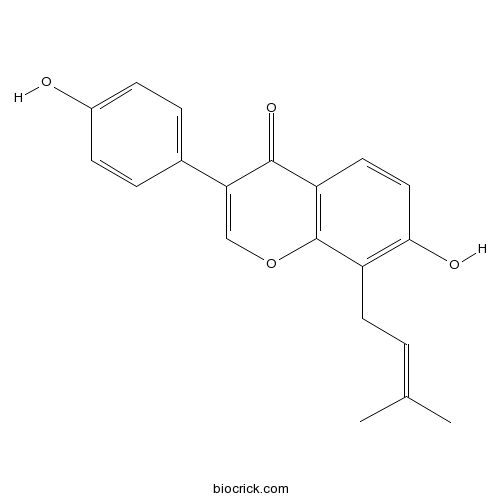8-PrenyldaidzeinCAS# 135384-00-8 |

Quality Control & MSDS
3D structure
Package In Stock
Number of papers citing our products

| Cas No. | 135384-00-8 | SDF | Download SDF |
| PubChem ID | 14841119 | Appearance | Powder |
| Formula | C20H18O4 | M.Wt | 322.36 |
| Type of Compound | Flavonoids | Storage | Desiccate at -20°C |
| Solubility | Soluble in Chloroform,Dichloromethane,Ethyl Acetate,DMSO,Acetone,etc. | ||
| Chemical Name | 7-hydroxy-3-(4-hydroxyphenyl)-8-(3-methylbut-2-enyl)chromen-4-one | ||
| SMILES | CC(=CCC1=C(C=CC2=C1OC=C(C2=O)C3=CC=C(C=C3)O)O)C | ||
| Standard InChIKey | NQKCBBHHFITUFF-UHFFFAOYSA-N | ||
| General tips | For obtaining a higher solubility , please warm the tube at 37 ℃ and shake it in the ultrasonic bath for a while.Stock solution can be stored below -20℃ for several months. We recommend that you prepare and use the solution on the same day. However, if the test schedule requires, the stock solutions can be prepared in advance, and the stock solution must be sealed and stored below -20℃. In general, the stock solution can be kept for several months. Before use, we recommend that you leave the vial at room temperature for at least an hour before opening it. |
||
| About Packaging | 1. The packaging of the product may be reversed during transportation, cause the high purity compounds to adhere to the neck or cap of the vial.Take the vail out of its packaging and shake gently until the compounds fall to the bottom of the vial. 2. For liquid products, please centrifuge at 500xg to gather the liquid to the bottom of the vial. 3. Try to avoid loss or contamination during the experiment. |
||
| Shipping Condition | Packaging according to customer requirements(5mg, 10mg, 20mg and more). Ship via FedEx, DHL, UPS, EMS or other couriers with RT, or blue ice upon request. | ||
| Description | 1.8-Prenyldaidzein has cytotoxic properties against P-388 cells, its IC 50 values 5.82 ug/mL, it also exhibits very high antioxidant activity against DPPH radical scavenging. |

8-Prenyldaidzein Dilution Calculator

8-Prenyldaidzein Molarity Calculator
| 1 mg | 5 mg | 10 mg | 20 mg | 25 mg | |
| 1 mM | 3.1021 mL | 15.5106 mL | 31.0212 mL | 62.0424 mL | 77.553 mL |
| 5 mM | 0.6204 mL | 3.1021 mL | 6.2042 mL | 12.4085 mL | 15.5106 mL |
| 10 mM | 0.3102 mL | 1.5511 mL | 3.1021 mL | 6.2042 mL | 7.7553 mL |
| 50 mM | 0.062 mL | 0.3102 mL | 0.6204 mL | 1.2408 mL | 1.5511 mL |
| 100 mM | 0.031 mL | 0.1551 mL | 0.3102 mL | 0.6204 mL | 0.7755 mL |
| * Note: If you are in the process of experiment, it's necessary to make the dilution ratios of the samples. The dilution data above is only for reference. Normally, it's can get a better solubility within lower of Concentrations. | |||||

Calcutta University

University of Minnesota

University of Maryland School of Medicine

University of Illinois at Chicago

The Ohio State University

University of Zurich

Harvard University

Colorado State University

Auburn University

Yale University

Worcester Polytechnic Institute

Washington State University

Stanford University

University of Leipzig

Universidade da Beira Interior

The Institute of Cancer Research

Heidelberg University

University of Amsterdam

University of Auckland

TsingHua University

The University of Michigan

Miami University

DRURY University

Jilin University

Fudan University

Wuhan University

Sun Yat-sen University

Universite de Paris

Deemed University

Auckland University

The University of Tokyo

Korea University
- 12alpha-Methoxygrandiflorenic acid
Catalog No.:BCN7771
CAS No.:135383-94-7
- 4'-Hydroxyisojasminin
Catalog No.:BCN7383
CAS No.:135378-09-5
- Isojasminin
Catalog No.:BCN7492
CAS No.:135378-08-4
- 5,7,3',4'-Tetrahydroxy-3-methoxy-8,5'-diprenylflavone
Catalog No.:BCN6848
CAS No.:1353676-65-9
- 8,8'-Bibaicalein
Catalog No.:BCN6549
CAS No.:135309-02-3
- MEN 10376
Catalog No.:BCC7133
CAS No.:135306-85-3
- 2''-O-Rhamnosylicariside II
Catalog No.:BCN3464
CAS No.:135293-13-9
- EW-7197
Catalog No.:BCC6467
CAS No.:1352608-82-2
- Pulchinenoside B
Catalog No.:BCN6554
CAS No.:135247-95-9
- Trijuganone C
Catalog No.:BCN3685
CAS No.:135247-94-8
- Pindolol
Catalog No.:BCC6881
CAS No.:13523-86-9
- AZD6738
Catalog No.:BCC6505
CAS No.:1352226-88-0
- CX-6258 hydrochloride hydrate
Catalog No.:BCC1505
CAS No.:1353858-99-7
- Bullatine A
Catalog No.:BCN2374
CAS No.:1354-84-3
- KH CB19
Catalog No.:BCC6135
CAS No.:1354037-26-5
- ACT 335827
Catalog No.:BCC6346
CAS No.:1354039-86-3
- trans-Ned 19
Catalog No.:BCC7825
CAS No.:1354235-96-3
- JW 480
Catalog No.:BCC6142
CAS No.:1354359-53-7
- 7-O-Prenylscopoletin
Catalog No.:BCN3547
CAS No.:13544-37-1
- Rehmapicrogenin
Catalog No.:BCN8507
CAS No.:135447-39-1
- Strontium Ranelate
Catalog No.:BCC3858
CAS No.:135459-87-9
- Araliadiol
Catalog No.:BCC8835
CAS No.:1354638-93-9
- Cabazitaxel intermediate
Catalog No.:BCN7432
CAS No.:1354900-65-4
- CYM 50260
Catalog No.:BCC6259
CAS No.:1355026-60-6
Potential defense-related prenylated isoflavones in lactofen-induced soybean.[Pubmed:21477824]
Phytochemistry. 2011 Jun;72(9):875-81.
An integrated LC-MS and NMR metabolomic study was conducted to investigate metabolites whose formation was induced by lactofen (1), a soybean (Glycine max L.) disease resistance-inducing herbicide. First, LC-MS analyses of control and lactofen (1)-induced soybean extracts were performed. The LC-MS raw data were then processed by a custom designed bioinformatics program to detect the induced metabolites so formed. Finally, structures of unknown induced metabolites were determined on the basis of their 1D and 2D NMR spectroscopic data. Structure of two previously unreported compounds, 7,8-dihydroxy-4'-methoxy-3'-prenylisoflavone (2) and 7-hydroxy-4',8-dimethoxy-3'-prenylisoflavone (3) were elucidated together with four known prenylated compounds, 3'-prenyldaidzein (4), 8-Prenyldaidzein (5), 3'-prenylgenistein (6), and 4-prenylcoumestrol (7). Compounds (2-6) are reported for the first time in soybean, as are the (13)C chemical shift assignments for compound (7). Formation of these six prenylated compounds was also induced by the primary defense glucan elicitor from the cell wall of the pathogen Phytophthora sojae (Kauf. and Gerde.), further suggesting a potential role in soybean defense. These results highlight the metabolic flexibility within soybean secondary product pathways and suggest that prenylation may be associated with defense responses. Moreover, this study demonstrates a promising future approach using metabolomics on elicitor-induced plants for discovery of unknown compounds even in relatively well studied plants.


